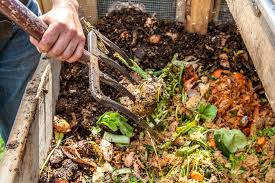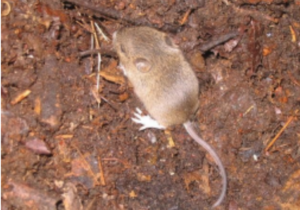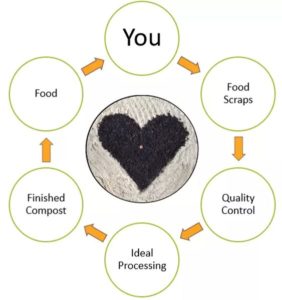By Adam Jankauskas
Compost is recognized as a valuable component of the ecological landscape – one that improves the soil as it slowly releases nutrients – and many ecological landscape practitioners utilize compost in the management of their properties. Compost has a place in a more sustainable world but providing composting services for clients can be unsustainable. How can composting be made easier without the added expense?
Compost Basics
First, let’s look at the composting process. There are several aspects to consider. Pile construction, balancing, moisture content, aeration, and particle size all greatly impact the actual composting process.
A proper composting “pile” will not be a pile at all. It is intentionally constructed in a large windrow or vessel system to retain heat. Brown and green materials are mixed according to their properties targeting a carbon to nitrogen ratio of 30:1 and a moisture content near 50%. This allows for the pile to achieve high temperatures that denature weed seeds and enables the material to process quickly without significant leachate runoff. To reduce the risk of odor the material must be turned on a regular basis to maintain oxygen levels. A proper compost process is aerobic, “with air.” Regular turning prevents the pile from going anaerobic, “without air.” Decomposition without oxygen is done by methane-producing bacteria. It is also beneficial to have ingredients vary in particle size for airflow by mixing chips, leaves, sawdust, and food material.
Managing Diverse Material
The challenge with composting yard trimmings and tree material is the length of time that this material takes to compost. The material breaks down slowly because it is extremely “brown” (heavy in carbon) and at times very dry. With a starting carbon to nitrogen ratio anywhere between 60:1 and 500+:1, this material can easily take years to compost while taking up valuable yard space.

For some practitioners, an alternative way for handling woody material is to let a brush pile build up and then seasonally burn it. It takes months for nature to grow vegetation, years to grow branches and small trees, and only minutes for us to lose this resource to flames. Composting this brush instead of burning it provides us with the opportunity to return the carbon and other nutrients to the earth where it will increase soil fertility.
Turn up the Heat
Heat retention will accelerate the process of composting of woody material. Containers introduce structure and insulation for heat retention, a minimum of 1 cubic yard per bay is recommended. Inside the container, landscape compostables once chipped or shredded can be balanced with materials, such as kitchen “waste,” that is heavier in nitrogen to approach the typically recommended starting carbon to nitrogen ratio of 30:1, typically described as 3:1 browns to greens by weight.
 Even with a properly constructed and maintained compost pile, there is always one area of concern that is difficult to avoid. Pests. A properly sized and balanced pile will increase greatly in temperature. Heat accelerates the composting process while also denaturing unwanted seeds and reducing harmful pathogens. The drawback is heat also makes a compost pile a warm home for rodents during the cooler months. When mixing in nitrogen-heavy material such as kitchen scraps for balancing, they also become a great food source for animals. Piles can also attract predatory wildlife attracted to prey.
Even with a properly constructed and maintained compost pile, there is always one area of concern that is difficult to avoid. Pests. A properly sized and balanced pile will increase greatly in temperature. Heat accelerates the composting process while also denaturing unwanted seeds and reducing harmful pathogens. The drawback is heat also makes a compost pile a warm home for rodents during the cooler months. When mixing in nitrogen-heavy material such as kitchen scraps for balancing, they also become a great food source for animals. Piles can also attract predatory wildlife attracted to prey.
In some areas, cities and towns have composting facilities, but they are often not geared toward the professional. Some sites limit the amount or type of material allowed, have high minimum costs, and offer limited drop off times.

One way to avoid the challenges of composting on-site or through a municipal or private site is to utilize a composting service. Composting services can be tailored to the needs of the individual landscaper. The professional can determine the frequency of pick up; alternatively, landscape material can be collected right at the client’s location. The landscape company saves time, fuel, and labor costs normally incurred when the material has to be transported to another location. A service can also provide reusable collection bags that avoid the need for disposable paper bags.
Composting at home or work could be an ecological way to manage landscape material. “Waste” becomes a valuable resource and is an environmental win. However, when local composting is not a viable option or when the cost of composting exceeds the benefits, a composting service is a great alternative. However you choose to compost, it is a win for the planet.
About the Author
Adam Jankauskas is the Founder of City Compost. City Compost offers complete composting solutions tailored to the needs of each client. They can handle loose piles of material but also offer reusable collection sacks. Service is available across Massachusetts, Rhode Island, and select parts of the rest of New England. Adam can be reached directly at adamj@citycompost.com. City Compost offers on-demand and variable frequency services right at your or your client’s location. Find all the details for their service and how they can help your own business save money at www.citycompost.com.

